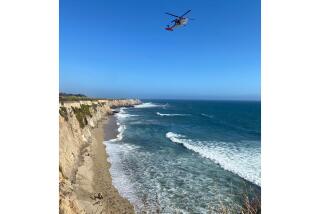Satellite Beams Radio Signal; Sailor Rescued
- Share via
SAN FRANCISCO — It was a Coast Guard helicopter that hoisted 50-year-old Jack Hoover from the cold, choppy seas where he had tossed about for 13 hours, but he owed his life to a satellite that had relayed his radio distress signal and summoned rescuers.
“I’m kind of beat, but it’s good to be alive,” Hoover, of Tracy, said from his hospital bed, where he was recuperating from hypothermia.
Hoover said he abandoned his 39-foot sloop at about 10 a.m. Saturday, when it began taking on water soon after he started sailing near the Farallon Islands, 25 miles west of San Francisco.
Wearing only foul-weather gear, not an insulated survival suit, Hoover launched his raft and took along food, a few flares, a strobe light and a $300 “emergency position indicator radio beacon” that relays a distress signal through one of three satellites.
Signal Relayed
Hoover had used his flares in vain attempts to attract two freighters that passed nearby, but he continued to operate the emergency beacon. Its signal is picked up by orbiting satellites and relayed to a computer at Scott Air Force Base in Illinois, 2,000 miles east of here. Scott Air Force Base called the Coast Guard in San Francisco, and the three-man helicopter crew was dispatched.
Hoover was clinging to the side of his rubber raft, bobbing in 50-degree, 8-foot swells and blown by 30-m.p.h. winds when he was spotted by a Coast Guard helicopter search party at 10:50 p.m. Saturday, according to Petty Officer Wayne Winner.
“It’s a pretty fantastic system,” Winner said. “We’re proud of it. There are three satellites that orbit the earth for this purpose, two Russian and one American.
More to Read
Sign up for Essential California
The most important California stories and recommendations in your inbox every morning.
You may occasionally receive promotional content from the Los Angeles Times.










